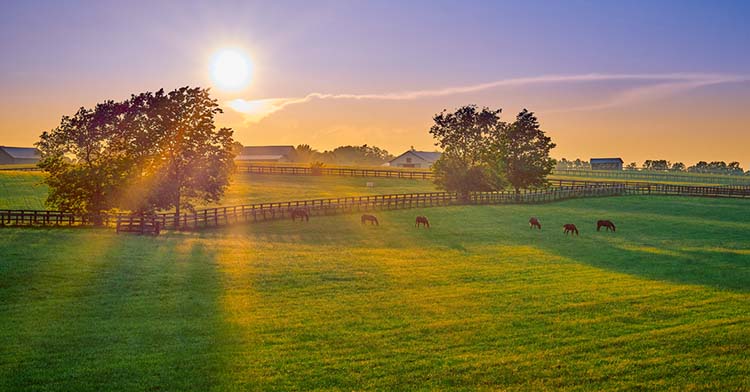
Succession planning is important for farmers and ranchers, especially those who have held their farms for generations.
Legacy farms and ranches often have highly appreciated assets such as buildings, land, machinery, and livestock. Divesting those assets before passing them on to the next generation, or selling after inheriting the family farm, will generate a taxable event if you realize a profit on the sale.
This article looks at capital gains taxes on farmland and how legacy planning can potentially allow farmers and ranchers to claim an exemption from this tax.
What are Capital Gains Taxes?
Capital gains taxes are generated when you sell an investment for a profit. You’ll pay the rate determined by your tax bracket if you held the investment for less than a year. If you held the asset for longer than a year, you’ll pay long-term capital gains taxes of 0, 15, or 20 percent depending on your annual income and filing status.
You’ll have to pay this tax in the same year you realize a profit. It’s reported on Schedule D of your Form 1040.
Selling Farmland and Capital Gains
Farmland prices in many areas of the country have steadily increased. Farm real estate in Massachusetts, for instance, rose 21 percent from 2017 to 2021 to $13,700 per acre, the U.S. Department of Agriculture’s National Agricultural Statistics Service (NASS) reports.1
Massachusetts may have had the largest increase in farmland prices in recent years, but the rest of the country is up as well. U.S. farmland sold for an average of $2,010 per acre in 2007 and jumped to $3,380 an acre in 2021, the NASS reports. Additionally, farmland in the U.S. decreased by 1.3 million acres in 2021.2 Since 2014, U.S. farmland has lost 13.62 million acres, primarily due to agricultural land being converted into commercial and residential development.
Farmland owners have cashed in on robust demand for developable land for new housing and commercial real estate. Farmers and ranchers with legacy properties likely sold at prices much higher than their original cost basis for the land. According to the American Farm Bureau Federation, you will owe capital gains if you sell farmland or ranchland, machinery, buildings, livestock, or timber for a profit.
Here’s where things can be complicated, though – especially for owners of legacy ranches and farms that have been handed down from previous generations. Capital gains are generated on realized profits. If you are the original owner of the farm and sell it outright to a developer, you’ll pay capital gains taxes on any profit above your cost basis in the farm. Physical assets such as corrals, barns, outbuildings, and other capital improvements to the farm will decrease your basis. Determining your basis, however, is crucial prior to sale.
Say you inherited farmland from your father. Your basis is the fair market value of the land at the time of inheritance. If your father’s basis in the property was $1 million, but the land now has a fair market value of $10 million, that’s your basis in the property. You inherit the land at the step-upped value.
If you sell the farm a year or two after inheriting it, you likely won’t owe much in capital gains because the asset won’t have appreciated much. However, if you held onto the farm for another 20 years, the farmland likely realized a significant increase in appreciated value, as noted above. Your capital gains taxes due would likely be a much larger portion of the overall sale price.
Here’s an example: You inherited the family farm in 2020 at a stepped-up basis of $2.5 million, and sold it in 2022 for $3 million. You’ll owe capital gains tax (0, 15, or 20 percent) on $500,000 in profit. However, if you inherited that same farm in 2000 at a stepped-up basis of $1 million but sold it in 2022 for $3 million, you’ll owe capital gains taxes on the $2 million in profit.
Gain from selling farmland is reported to the IRS on Form 4797: Sale of Business Property.
How to Get an Exemption on Capital Gains Taxes When Selling Farmland
There are two scenarios here.
- Transfer the asset to the next generation, who receives it at a step-up in basis to the current fair market value. If they sell the property a few years later, the capital gains taxes owed will be much lower.
- Complete a 1031 exchange to defer capital gains. You’ll have to reinvest the entire sale proceeds into a like-kind asset, and if you divest that asset you’ll have to pay the deferred capital gains tax.
Legacy planning for farmers and ranchers can be complicated and likely involves many more moving parts than discussed here. If you are planning on selling your farm, it would be prudent to talk about your particular situation with a certified financial planner or tax professional to determine your cost basis in the property and potential ways to reduce your tax burden.
1Land Values, USDA, https://www.nass.usda.gov/Publications/Todays_Reports/reports/land0821.pdf
2Farms and Land in Farms, USDA, https://www.nass.usda.gov/Publications/Todays_Reports/reports/fnlo0222.pdf
This material is for general information and educational purposes only. Information is based on data gathered from what we believe are reliable sources. It is not guaranteed as to accuracy, does not purport to be complete and is not intended to be used as a primary basis for investment decisions. It should also not be construed as advice meeting the particular investment needs of any investor.
Realized does not provide tax or legal advice. This material is not a substitute for seeking the advice of a qualified professional for your individual situation.
Costs associated with a 1031 transaction may impact investor’s returns and may outweigh the tax benefits. An unfavorable tax ruling may cancel deferral of capital gains and result in immediate tax liabilities.
Examples shown are hypothetical and for illustrative purposes only.



